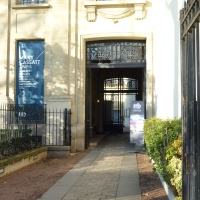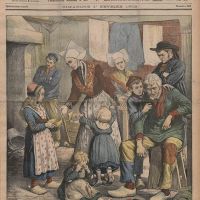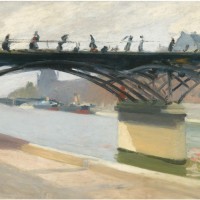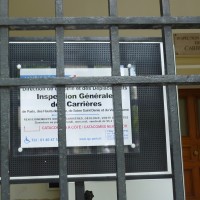The Parisienne colonne sèche is not a medical condition or procedure. However, a colonne sèche could be very good for your health, particularly in the event of a fire. There is no need to look hang-dog about it.
Paris is blessed with a richly imaginative design and artistic culture. In the image above, a few deft changes to an existing utilitarian object transformed a colonne sèche into an humorous bit of street art.
On a walk along the avenue Matignon, I noticed two muscular figures holding up a building on their shoulders.
They led me to this find: gorgeously sculptured door handles.
And to the most ornate colonne sèche I have ever seen.
So what is a colonne sèche and why might it be good for your health?
I had always known of them as standpipes. They are an essential part of fire fighting equipment for taller buildings. The water pressure from fire hydrants cannot raise the water beyond a few storeys. Moreover, fire hoses either have to spray on the fire from outside or be dragged up the stairs to the fire, and believe me, fire hoses are very heavy. Here is where the colonne sèche or standpipe saves the day when connected to another piece of equipment: the pumper truck.
The colonne sèche is a pipe to bring high-pressure fire-fighting water to locations inside a building. The water comes from a pumper truck which, when connected to the colonne sèche, pumps water to various parts of the building. Inside the building, one will find carefully folded fire hoses and nozzles already hooked up and ready to be pulled from a rack. Once turned on and connected to the pumper truck by the colonne sèche, the hoses are ready to go to work. The system is fast, reliable, and saves lives.
And as we shall see, most buildings have more than one.
This image provides a good picture of what is involved at street level. At the bottom we see two colonnes sèches. On each one, the end cap may be unscrewed so the hose from the pumper truck can be attached to the either or both. Reading the text we see each colonne sèche goes to either stairway (Escalier) A or B. At the top, we find a map to aid firefighters in finding the other ends of the colonnes sèches in the building and understanding the layout.
Here, one colonne sèche supplies water to the Central Stairway and the Basement level or underground level (Escalier Central et Sous-Sol). The other is near the Left Stairway (Escalier Gauche) but we are not told at which level, probably all.
This combination of signs first warns drivers not to park any time, day or night (Jour et Nuit), and then indicates that the colonne sèche is for the right staircase area (Escalier Droit).
I photographed this bank of colonnes sèches outside a Bureau de Poste (post office). We can see that the colonnes sèches are located at four stairways. For the first and second, the word montante (rising or ascending) and the arrows pointing up leave no doubt that these send water upwards. For the third and fourth, the arrows are pointing down or descendante (descending or falling). Note that the end caps are attached to the wall by a chain.
As Philippa and I walked along rue Marbeuf, she must have known I couldn’t pass this loading dock’s wonderful display without taking a photograph. Eight colonnes sèches (a personal best in this highly specialized category).
Look closer. Eight colonnes sèches but only six red labels. Each label has screw holes, but is actually held in place by double-sided tape. Numbers 3 and 8 are missing, leaving only the remains of double-sided tape. One suspects, and hopes, that at least in areas with a high concentration of workers, businesses, residents, and tourists, as well as valuable real estate, firefighters have digital data on interior layouts and colonnes sèches.
You now know more than you ever thought you would about something you have probably never stopped to consider. And why in a city as varied and gorgeous as Paris would I bother to look at such mundane things? Perhaps because the more you know, the more you see, and the more you see, the more you know.
And what we particularly want to know and see are the ways of reading Paris streets. This is why I muse about chimney pots and their trails they make on the sides of buildings. It’s why I take pictures of chasses-roues and read up on the the dual water system that keeps the streets of Paris so clean. I am endlessly fascinated by parking arrangements and delivery vehicles and anti-theft devices. It’s all about making sense of the city through its streets.
Text and photographs by Norman Ball






























Love your Parisian Fields….and learning about ALL the things I wonder about too !!
Brilliant post! I’ve long wondered about the purpose of these mysteriously named protrusions but have apparently been too lazy to research them on my own. Thanks for helping round out my Paris education!
This was great, I’d never have believed that stand pipes (or dry risers as they are known here) would be so fascinating, absolute brilliance – thank you once again for making Sunday evenings so enjoyable
Delighted you enjoyed it Ian. I have a great deal of fun learning and writing about material things as well as other things. Thanks for teaching me the UK term. Dry risers and colonne sèche are much more descriptive than standpipe. Well, maybe not, standpipes are pipes standing by waiting to be put to work.
I never had the level of curiosity you do, which is quite wonderful. Thanks.
Pingback: The Paris Blog: Paris, France Expat Tips & Resources »Blog Archive » The Colonne Sèche
What a fantastic post! I can’t wait to read more. Just brilliant.